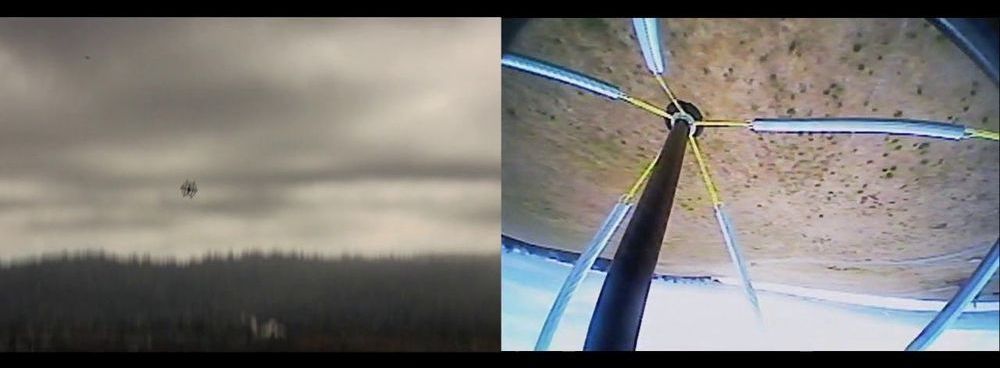Archive for the ‘space’ category: Page 770
May 8, 2019
Squishy robots can drop from a helicopter and land safely
Posted by Victoria Generao in categories: robotics/AI, space, transportation

“Tensegrity” robots could safely explore disaster zones, or even the surface of Saturn’s moon.
📣Discovery Alert: These three new planets are 🔥🔥🔥.
📣 Discovery Alert: These three new planets are 🔥 🔥 🔥
Qatar-8b, 9b and 10b are all gas giants like our own Jupiter and Saturn, but in such tight orbits \xE2\x95️ around their parent stars ☀️ that they hover between 1,457 degrees to 3,000 degrees F.
May 7, 2019
Twisting whirlpools of electrons
Posted by Quinn Sena in categories: biotech/medical, space
In Jules Verne’s famous classic 20,000 Leagues Under the Sea, the iconic submarine Nautilus disappears into the Moskenstraumen, a massive whirlpool off the coast of Norway. In space, stars spiral around black holes; on Earth, swirling cyclones, tornadoes and dust devils rip across the land.
All these phenomena have a vortex shape, which is commonly found in nature, from galaxies to milk stirred into coffee. In the subatomic world, a stream of elementary particles or energy will spiral around a fixed axis like the tip of a corkscrew. When particles move like this, they form what we call “vortex beams.” These beams imply that the particle has a well-defined orbital angular momentum, which describes the rotation of a particle around a fixed point.
Thus, vortex beams can give us new ways of interacting with matter, e.g. enhanced sensitivity to magnetic fields in sensors, or generating new absorption channels for the interaction between radiation and tissue in medical treatments (e.g. radiotherapy). But vortex beams also enable new channels in basic interactions among elementary particles, promising new insights into the inner structure of particles such as neutrons, protons or ions.
May 7, 2019
Scientists Think They’ve Found the Ancient Neutron Star Crash That Showered Our Solar System in Gold
Posted by Quinn Sena in category: space
An ancient neutron star collision occurred very, very close to our solar system — and we’re all the better for it.
May 7, 2019
How Epic & ILM’s John Knoll Tried to Recreate the Moon Landing for Microsoft’s Build 2019 Keynote
Posted by Klaus Baldauf in categories: augmented reality, space

In the end, it wasn’t meant to be. Microsoft had pulled out all the stops for its Build 2019 developer conference keynote on Monday morning. The company had partnered with Epic Games and Industrial Light & Magic chief creative officer John Knoll for a hugely ambitious demo of its Hololens 2 headset that aimed to recreate the Apollo 11 moon landing, 50 years after the fact, in mixed reality.
All had worked out well during multiple rehearsals over the last few days. But when Knoll and science journalist and “Man on the Moon” author Andrew Chaikin were set to go on stage on Monday, the demo just didn’t run. Microsoft stalled by extending its pre-show ImagineCup competition until the show’s moderator couldn’t think of any more questions to ask. Then Knoll and Chaikin went on stage, giving it one more go — and the mixed-reality overlays simply refused to appear.
Blue supergiants are the rock-and-roll stars of the universe. They are massive stars that live fast and die young which makes them rare and difficult to study, even with modern telescopes.
Before space telescopes, few blue supergiants had been observed, so our knowledge of these stars was limited.
Leading astrophysicist Dr. Tamara Rogers, from Newcastle University, UK, and her team have been working for the past five years to create simulations of stars like these to try to predict what it is that makes the surface appear the way it does.
Continue reading “Secrets of the ‘blue supergiant’ revealed” »
May 6, 2019
These Robot “Bees” Will Help Out Astronauts
Posted by Quinn Sena in categories: robotics/AI, space
May 6, 2019
Nearby collision of two neutron stars sprinkled our solar system with precious heavy elements
Posted by Quinn Sena in category: space
A cataclysmic collision between a pair of dead stars may have seeded our solar system with precious heavy metals including gold and uranium, according to a newly published study. If such an event were to be observed in the present day, it would be the brightest point in the night sky.
















